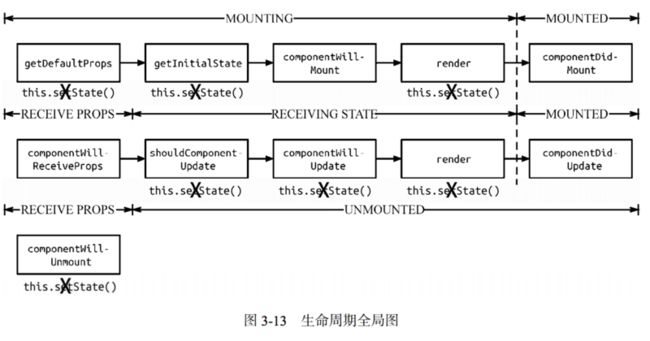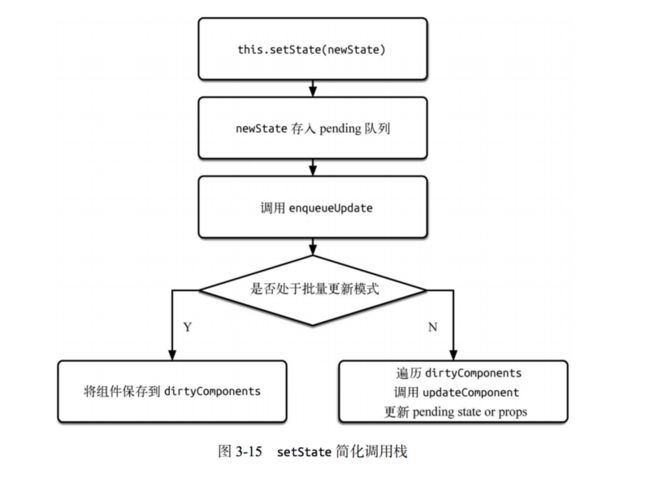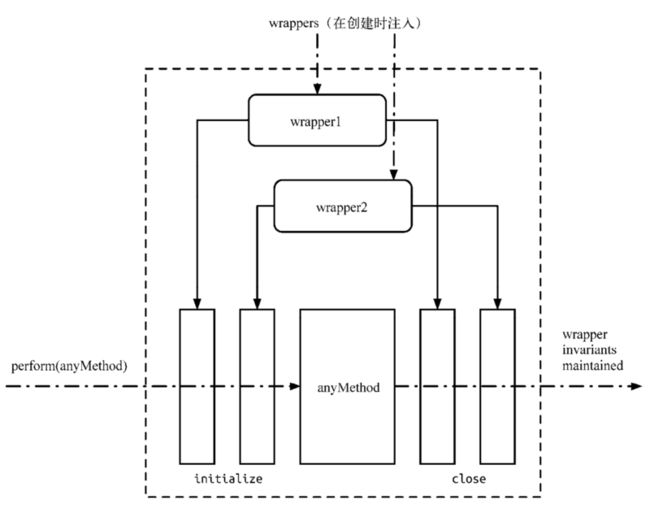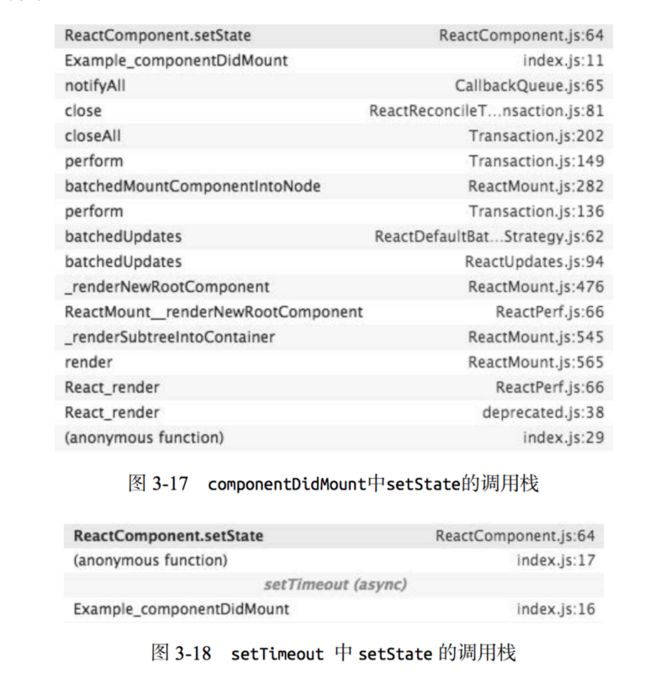承接上文,深入React知识点整理(一)
使用React也满一年了,从刚刚会使用到逐渐探究其底层实现,以便学习几招奇技淫巧从而在自己的代码中使用,写出高效的代码。下面整理一些知识点,算是React看书,使用,感悟的一些总结:
- React 生命周期
- setState调用栈
7.React 生命周期
React 的主要思想是通过构建可复用组件来构建用户界面。所谓组件,其实就是有限状态机(FSM),通过状态渲染对应的界面,且每个组件都有自己的生命周期,它规定了组件的状态和方法需要在哪个阶段改变和执行。有限状态机,表示有限个状态以及在这些状态之间的转移和动作等行为的模型。一般通过状态、事件、转换和动作来描述有限状态机。
组件的生命周期在不同状态下的执行顺序:
- 当首次挂载组件时,按顺序执行
getDefaultProps、getInitialState、componentWillMount、render和componentDidMount。 - 当卸载组件时,执行
componentWillUnmount。 - 当重新挂载组件时,此时按顺序执行
getInitialState、componentWillMount、render和componentDidMount,但并不执行getDefaultProps。 - 当再次渲染组件时,组件接受到更新状态,此时按顺序执行
componentWillReceiveProps、shouldComponentUpdate、componentWillUpdate、render和componentDidUpdate。
constructor 中的 this.state = {} 其实就是调用内部的 getInitialState 方法。
自定义组件(ReactCompositeComponent)的生命周期主要通过 3 个阶段进行管理——MOUNTING、RECEIVE_PROPS 和 UNMOUNTING,它们负责通知组件当前所处的阶段,应该执行生命周期中的哪个步骤。
- 创建组件:createClass或者extend Component创建自定义组件,初始化defaultProps。
- MOUNTING:调用
getInitialState初始化state,调用componentWillMount,之后render,最后调用componentDidMount。通过mountComponent挂载组件,初始化序号、标记等参数,判断是否为无状态组件,并进行对应的组件初始化工作,比如初始化props、context等参数。利用getInitialState获取初始化state、初始化更新队列和更新状态。
- RECEIVE_PROPS:当参数变化的时候,按照图中顺序调用,且在
componentWillReceiveProps、shouldComponentUpdate和componentWillUpdate中也还是无法获取到更新后的 this.state,即此时访问的 this.state 仍然是未更新的数据。updateComponent本质上也是通过递归渲染内容的,由于递归的特性,父组件的componentWillUpdate是在其子组件的componentWillUpdate之前调用的,而父组件的componentDidUpdate也是在其子组件的componentDidUpdate之后调用的。
- UNMOUNTING:如果存在
componentWillUnmount,则执行并重置所有相关参数、更新队列以及更新状态,如果此时在componentWillUnmount中调用 setState,是不会触发 re-render 的,这是因为所有更新
队列和更新状态都被重置为 null,并清除了公共类,完成了组件卸载操作。
最后,一张图归纳React生命周期,以及不同生命周期中setState的使用情况:
屏幕快照 2017-12-14 下午10.42.31.png
这里主要介绍了React生命周期执行顺序,以及在不同生命周期内使用setState的情况,重点在于合适使用setState。
8.setState调用栈
React中的setState是个很著名的方法,当你需要更改state触发页面重绘的时候,调用setSatet方法。但是setState并不会立刻执行你的更改,这也是刚开始使用React时很苦恼的一件事。
经过一段时间的使用和学习,知道了React的setState是'异步'的:
State Updates May Be Asynchronous
React may batch multiple
setState()calls into a single update for performance.Because
this.propsandthis.statemay be updated asynchronously, you should not rely on their values for calculating the next state.
官方给出的回答是React为了优化性能,会合并多次setState操作,并计算出最终值再执行,所以setState看起来是'异步'的。这种想法很好,我们可以借鉴到项目开发中去,但是代码层面是如何实现的?在任何地方调用setState都会是’异步的吗‘?
setState源码:
// 更新 state
ReactComponent.prototype.setState = function (partialState, callback) {
this.updater.enqueueSetState(this, partialState);
if (callback) {
this.updater.enqueueCallback(this, callback, 'setState');
}
};
...
enqueueSetState: function (publicInstance, partialState) {
var internalInstance = getInternalInstanceReadyForUpdate(
publicInstance,
'setState'
);
if (!internalInstance) {
return;
}
// 更新队列合并操作
var queue = internalInstance._pendingStateQueue || (internalInstance._pendingStateQueue = []);
queue.push(partialState);
enqueueUpdate(internalInstance);
},
...
// 如果存在 _pendingElement、_pendingStateQueue和_pendingForceUpdate,则更新组件
performUpdateIfNecessary: function (transaction) {
if (this._pendingElement != null) {
ReactReconciler.receiveComponent(this, this._pendingElement, transaction, this._context);
}
if (this._pendingStateQueue !== null || this._pendingForceUpdate) {
this.updateComponent(transaction, this._currentElement, this._currentElement, this._context,
this._context);
}
} 通过上面源码大致可以看出,setState函数执行的时候,把被更新的state放入到_pendingStateQuenue队列中,之后将组件实例传入并执行enqueueUpdate,并且如果有回调函数放到enqueueCallback中。
问题现在全在enqueueUpdate上,通过简易的流程图可以看出enqueueUpdate判断当前组件是否处于批量更新模式中,是就简单将组件存入脏组件队列,不是的话更新脏组件队列,从而更新调用updateComponent,更新props和state,触发页面重绘。
屏幕快照 2017-12-07 下午7.46.18.png
到这里可以看到很清楚地看到,setState并不是全部都是’异步的‘,当组件处于非批量更新模式的时候,是立即更新的。enqueueUpdate源码:
function enqueueUpdate(component) {
ensureInjected();
// 如果不处于批量更新模式
if (!batchingStrategy.isBatchingUpdates) {
batchingStrategy.batchedUpdates(enqueueUpdate, component);
return;
}
// 如果处于批量更新模式,则将该组件保存在 dirtyComponents 中
dirtyComponents.push(component);
} batchingStrategy代码如下:
var ReactDefaultBatchingStrategy = {
isBatchingUpdates: false,
batchedUpdates: function(callback, a, b, c, d, e) {
var alreadyBatchingUpdates = ReactDefaultBatchingStrategy.isBatchingUpdates;
ReactDefaultBatchingStrategy.isBatchingUpdates = true;
if (alreadyBatchingUpdates) {
callback(a, b, c, d, e);
} else {
transaction.perform(callback, null, a, b, c, d, e);
}
},
} 通过代码来看,isBatchingUpdates默认是false,也就是组件默认是不处于批量更新模式的,第一次执行enqueueUpdate时候,在batchedUpdates方法中,将开关置true,之后更新都处于批量更新模式。
这里还有一个概念:事务。
事务就是将需要执行的方法使用 wrapper 封装起来,再通过事务提供的 perform 方法执行。而在 perform 之前,先执行所有 wrapper 中的 initialize 方法,执行完 perform 之后(即执行method 方法后)再执行所有的 close 方法。一组 initialize 及 close 方法称为一个 wrapper。从图3-16中可以看出,事务支持多个 wrapper 叠加。
那事务又跟setState有什么关系,我们举个例子:
import React, { Component } from 'react';
class Example extends Component {
constructor() {
super();
this.state = {
val: 0
};
}
componentDidMount() {
this.setState({val: this.state.val + 1});
console.log(this.state.val); // 第 1 次输出
this.setState({val: this.state.val + 1});
console.log(this.state.val); // 第 2 次输出
setTimeout(() => {
this.setState({val: this.state.val + 1});
console.log(this.state.val); // 第 3 次输出
this.setState({val: this.state.val + 1});
console.log(this.state.val); // 第 4 次输出
}, 0);
}
render() {
return null;
}
} 这个例子中,componentDidMount生命周期函数中连着调用了两次setState,之后在setState中又连着调用了两次,结果却完全不同,打印输出0,0,2,3。尝试着在React的各个阶段函数中打印log结果如下:
通过截图可以看到,我们在调用setState的之后,打印输出了事务结束的closeAll,这说明componentDidMount函数被事务当做method调用,之后才打印输出batchedUpdates。原来早在 setState 调用前,已经处于batchedUpdates 执行的事务中了。那这次 batchedUpdate 方法,又是谁调用的呢?让我们往前再追溯一层,原来是 ReactMount.js中的 _renderNewRootComponent 方法。也就是说,整个将 React 组件渲染到 DOM 中的过程就处于一个大的事务中。
接下来的解释就顺理成章了,因为在 componentDidMount 中调用 setState 时,batchingStrategy的 isBatchingUpdates 已经被设为 true,所以两次 setState 的结果并没有立即生效,而是被放进了 dirtyComponents 中。这也解释了两次打印 this.state.val 都是 0 的原因,因为新的 state 还没有被应用到组件中。而setTimeout函数中的setState并没有在事务中,所以立即执行。
所以这里得到一个结论:在React中,如果是由React引发的事件处理(比如通过onClick引发的事件处理),调用setState不会同步更新this.state,除此之外的setState调用会同步执行this.state。
React引发的事件处理有很多,都是我们常用的比如所有的生命周期函数(在生命周期函数中可以使用setState的),React代理的事件;这些函数应用场景很高,让我们误以为setState一直是'异步'的。
所以,我们也可以得出解决setState异步的方法:
- 使用setState第二个参数callback;
- setTimeout函数(虽然不好,但也不失为一种办法);
- 在componentDidUpdate处理一些逻辑(要看应用场景);
- 第一个参数传入计算函数;
当然了,还有一个比较决绝的办法,就是不用setState。
相关文章可以看看程墨老师的文章:setState为什么不会同步更新组件状态。
总结
React算是一个颠覆式的UI框架,有很多知识点值得学习,深入的研究一些问题对于实际使用上也会有一定帮助。本文也是根据《深入React技术栈》前几章内容摘录,整理的知识点,有兴趣可以看看原著。




